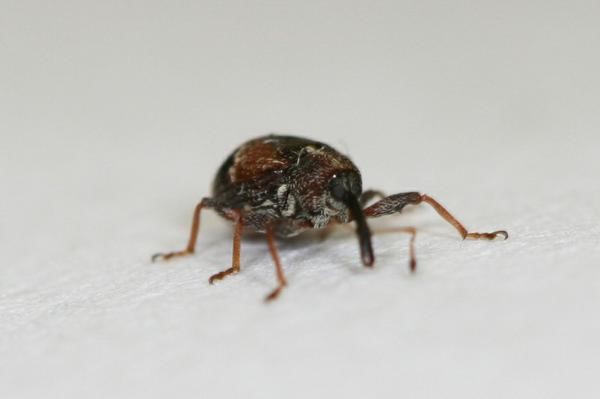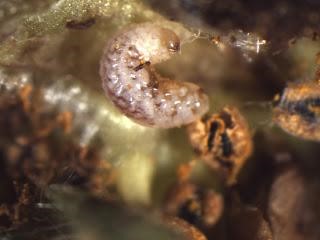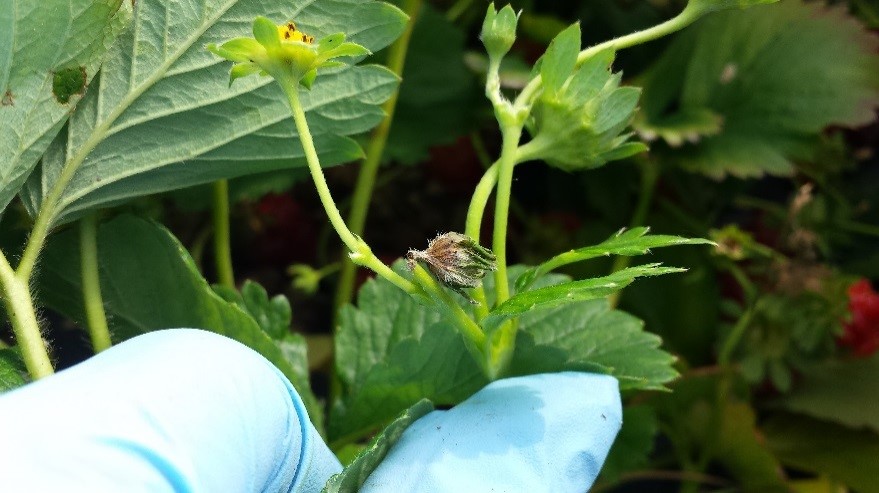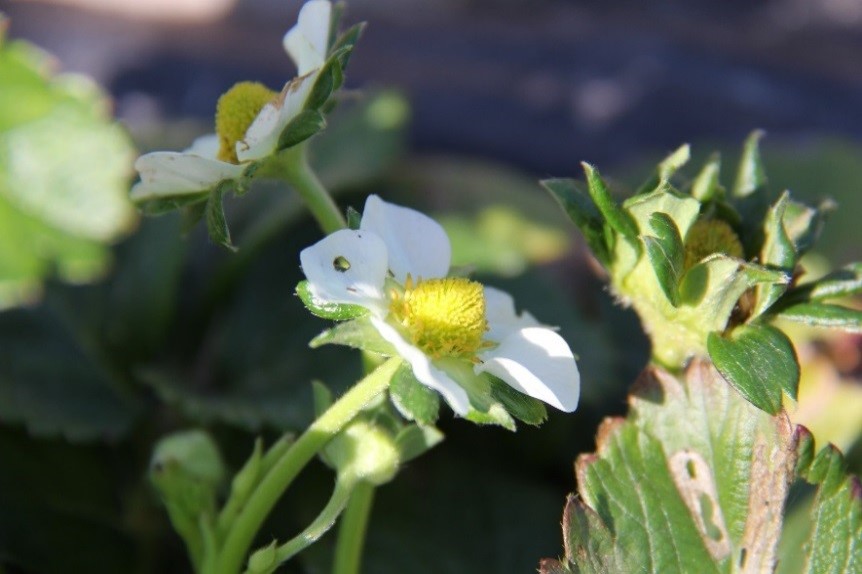Douglas G. Pfeiffer1, Dept. Entomology, Virginia Tech, Blacksburg VA; and Jayesh Samtani2, Hampton Roads Agricultural Research and Extension Center, Virginia Tech, Virginia Beach, VA

(photo by Hannah Burrack, NC State Extension)

(photo by Hannah Burrack, NC State Extension)
The strawberry bud weevil, Anthonomus signatus Say (also known simply as clipper), has long been considered one of the most important direct pests of strawberries in the United States. This pest has been reported to cause yield losses from 50 to 100% in some areas (Schaefers, 1981). The adult weevil is a snout beetle about 1/10 inch (3 mm) long, chestnut brown in color (Fig. 1), and possessing two black spots on its back (elytra). Larvae are tiny creamy white-colored grubs found inside unopened flower buds (Fig 2). A related species, A. rubi, causes similar injury to strawberries in Europe and western Asia (Aasen & Trandem, 2006).
The strawberry bud weevil is widespread and occurs throughout virtually all the strawberry-growing regions of this country (Anderson & Walker, 1937). Strawberry bud weevil has one generation per year. The phenology and development of the strawberry bud weevil were monitored in strawberry fields in the northern part of its range, in southern Quebec. There was 1:1 (male/female) sex ratio in spring and summer. About 63 days were required for development from egg to adult. Spring adult emergence occurs within a very short time period as temperature highs near 60 °F (Mailloux & Bostanian,1993). Overwintering adults emerge early in the season from ground litter commonly in wooded areas and migrate to strawberry fields in April (timing will vary with the region). Ovipositing females puncture unopened buds with their long snout and deposit a single egg into the bud. Damage results when females sever the strawberry bud from the pedicel following egg laying, causing it to hang by part of the stem, or fall to the ground, thus, preventing fruit formation (Fig. 3). Often, the damaged blossoms upon opening have shot holes on the petals (Fig. 4). Larvae develop in the severed buds and reach maturity in 3-4 weeks. Adults emerge in June, feed on flower pollen, then enter an estivation in mid-summer and remain inactive the rest of the season.

(photo by J. Samtani)

(photo by J. Samtani)
Field scouting/monitoring and action thresholds
One method of field scouting involves sampling weevils on plants, during the early blossom/bud stage. Schaefers (1981) suggests an economic injury level of 1 female beetle per 40 row feet. Cooley & Schloemann (1990) developed a sampling program based on bud damage and advise treatment if an average of 0.6 clipped buds per row foot are found. Bostanian et al. (1999) reported sweep net sampling to be effective for determining clipper presence and population. A low action threshold has been used for strawberry bud weevil; Pritts et al. (1999) recommended a threshold of two clipped buds/meter of row. This was because pest managers and growers have assumed that one clipped flower bud results in the loss of one average-sized fruit.
Recent research has shown that percent clipped buds do not entirely correspond with percent crop loss. Some strawberry varieties compensate for some fruit loss by the surviving fruit growing to a larger size (English-Loeb et al., 1999). Similar observations in North Carolina (Burrack 2014) indicate that at some injury levels sprays may not be needed, but further research is needed.
Control
Chemical control:
In the 2022 Southern Region Strawberry pest management recommendations, three insecticides are recommended for strawberry bud weevil: Brigade (bifenthrin), Danitol (fenpropathrin), and Sevin (carbaryl). It should be noted that all three materials, especially the pyrethroids, are toxic to predatory mites and other natural enemies. Caution should be used, with vigilance for population build-up of two-spotted spider mite.
Cultural control:
Pistillate varieties of strawberries are relatively immune from attack since only varieties with staminate flowers seem to provide adequate food for developing larvae (Davidson & Lyon 1987). Early-fruiting varieties such as ‘Sweet Charlie’, ‘Rocco’ and ‘Ruby June’, would be phenologically be more susceptible to attack than later-fruiting varieties. For matted-row production, Schaefers (1981) recommends topping of plants and removal of foliage and mulch immediately following harvest, then applying a follow-up chemical spray to kill overwintering adults. Other cultural practices include avoiding field site selection near wooded areas to prevent high numbers of overwintering adults from entering the field in the spring. Mulches and full canopy beds encourage adults to overwinter and remain in the field. Plowing old beds immediately following harvest causes adult mortality. Cropping fields for less than three years is also a beneficial practice.
References
Aasen, S. S. and N. Trandem. 2006. Strawberry blossom weevil Anthonomus rubi Herbst (Col.: Curculionidae): Relationships between bud damage, weevil density, insecticide use, and yield. J. Pest Sci. 79:169-174.
Anderson, L.D. and H.G. Walker. 1937. Dusting to Control Strawberry Weevil in Virginia, Journal of Economic Entomology, 30(3):437–438, https://doi.org/10.1093/jee/30.3.437
Bostanian, N. J., M. Binns, J. Kovach, G. Racette and G Mailloux. 1999. A predictive model for strawberry bud weevil adults in strawberry fields. Environ. Entomol 28:388-406.
Burrack, H. 2014. Strawberry clipper weevils in strawberry. NC State Extension web page.
Cooley, D. and S. Schloemann. 1990. Chapter 8. In Strawberry Production Guide for the Northeast, Midwest, and Eastern Canada. Pp, 66-75.
Davidson, R. H. & W. F. Lyon. 1979. Insect Pests of Farm, Garden, and Orchard. Wiley, N.Y. 596 p.
English-Loeb, G., M. P. Pritts, J. Kovach, R. Rieckenberg and M. J. Kelly. 1999. Compensatory ability of strawberries for bud and flower removal: Implications for managing the strawberry bud weevil. J. Econ. Entomol. 92:915-921.
Kovach, J., R. Rieckenberg, G. English-Loeb, and M. Pritts. 1999. Oviposition patterns of the strawberry bud weevil (Coleoptera: Curculionidae) at two spatial scales and implications for management. J. Econ. Entomol. 92:1358-1363.
Mailloux, G. and N J. Bostanian.1993. Development of the strawberry bud weevil (Coleoptera: Curculionidae) in strawberry fields. Ann. Entomol. Soc. Am. 86:384–393.
Pritts, M., M. J. Kelly and G. English-Loeb. 1999. Strawberry cultivars compensate for simulated bud weevil damage in matted row plantings. HortScience 34:109-111.
Schaefers G.A, and C.H. Shanks. 1981. Pest management systems for strawberry insects. In: Pimentel D (eds) CRC Handbook of Pest Management in Agriculture vol III, 2nd edn. CRC Press, Boca Raton, pp 535–552.